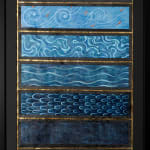Yasmin Hayat
The Seven Seas, 2023
23.5 carat genuine yellow gold, Palladium Indian ink, genuine indigio, Hematite, Watercolour on Indian Hemp paper
30.31 x 17.32ins (77 x 44cm) (artwork size)
35.43 x 22.24ins (90 x 56.5cm) (framed size)
35.43 x 22.24ins (90 x 56.5cm) (framed size)
Copyright The Artist
Sold
Further images
'Throughout medieval Islamic manuscripts, stories, and historical paintings, the sea played a central role. These tales often featured a colossal fish, whale, or sea serpent named Bahamoot who was believed...
"Throughout medieval Islamic manuscripts, stories, and historical paintings, the sea played a central role. These tales often featured a colossal fish, whale, or sea serpent named Bahamoot who was believed to support the seven seas upon his back.
According to these historic texts, this mythical creature was responsible for natural phenomena such as the ebbing of the tides. As the whale drank the water of the earth, it countered rising sea-levels and allowed us to live in harmony with the ocean. I found this story intriguing as variations of it can be found in folkloric stories from the Australian aboriginals to the Japanese, who have their own tidal-causing fish named Jinshin-Uwo.
This cross-cultural whale inspired me to paint a picture of the seven seas. The concept of the Seven Seas has been used in various cultures and at different times in history to refer to bodies of water along trade routes, regional bodies of water, or exotic and far-away bodies of water. Using Indian hemp that arrived by sea, I created a painting that depicts the various moods and depths of our ocean. I used different techniques and stylizations taught to me by my Indian-Persian manuscript masters teachers."
According to these historic texts, this mythical creature was responsible for natural phenomena such as the ebbing of the tides. As the whale drank the water of the earth, it countered rising sea-levels and allowed us to live in harmony with the ocean. I found this story intriguing as variations of it can be found in folkloric stories from the Australian aboriginals to the Japanese, who have their own tidal-causing fish named Jinshin-Uwo.
This cross-cultural whale inspired me to paint a picture of the seven seas. The concept of the Seven Seas has been used in various cultures and at different times in history to refer to bodies of water along trade routes, regional bodies of water, or exotic and far-away bodies of water. Using Indian hemp that arrived by sea, I created a painting that depicts the various moods and depths of our ocean. I used different techniques and stylizations taught to me by my Indian-Persian manuscript masters teachers."






